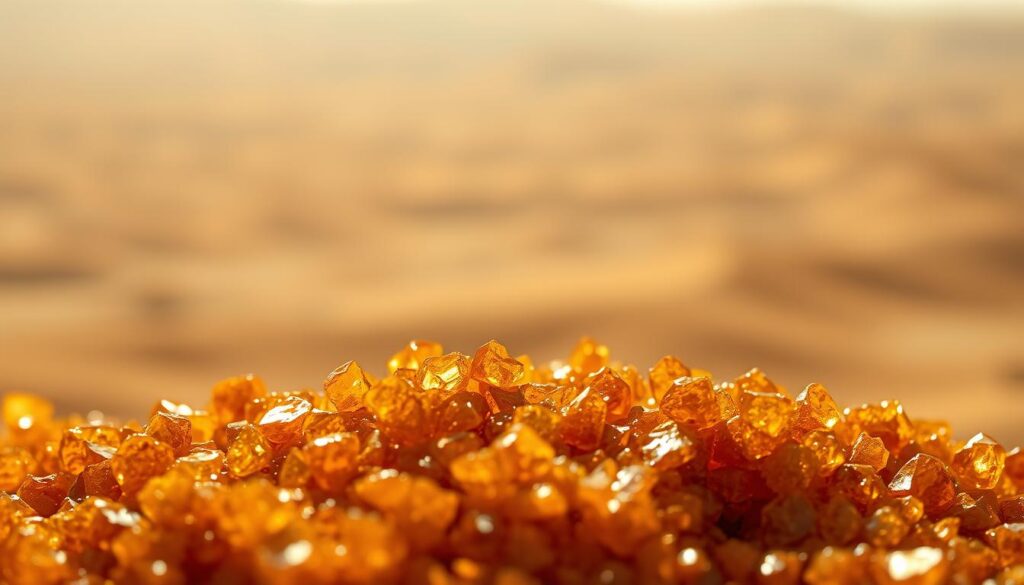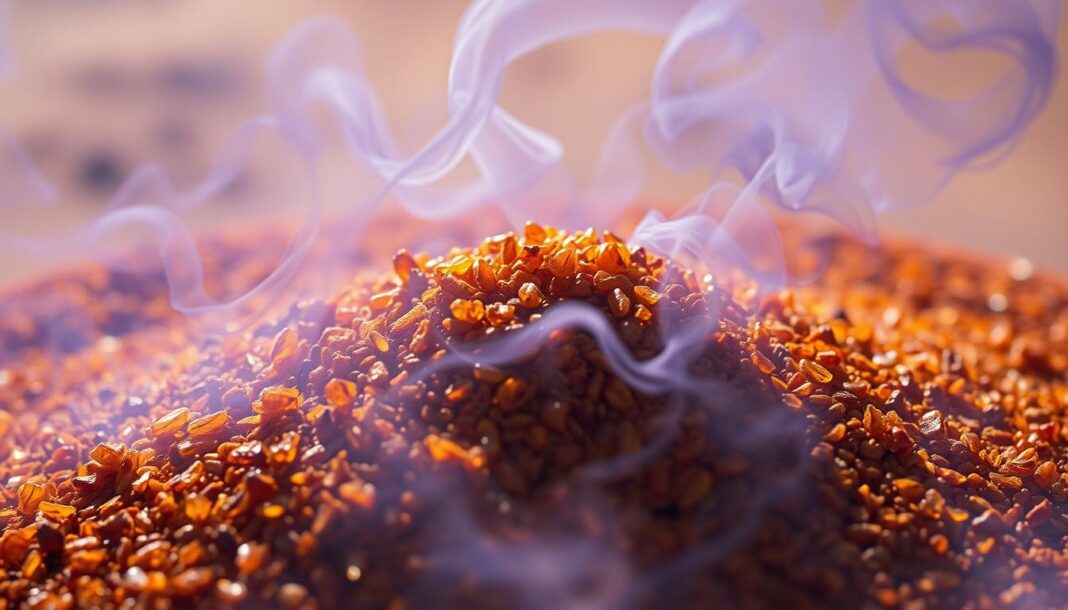We explore the fictional psychedelic drug melange, often referred to as “the spice,” central to Frank Herbert’s Dune series. This substance is not only a culinary phenomenon but also a cultural touchstone, driving the economy and politics of the universe within the novels.
The spice melange has captivated readers with its cinnamon-like flavor profile, making it one of the most iconic fictional substances in science fiction literature. As we examine the significance of melange, we will discuss its origins, properties, and cultural impact, as well as its real-world parallels.
Key Takeaways
- Understanding the cultural significance of melange in the Dune universe.
- Exploring the flavor profile of the spice and its impact on readers.
- Examining the role of melange as a commodity in the Dune economy and politics.
- Discussing the real-world inspirations for Herbert’s creation of melange.
- Overview of the spice’s origins, properties, and cultural significance.
The Essence of Arrakis Spice
In the vast expanse of the Dune universe, the spice melange stands out as a substance of unparalleled significance. We explore the essence of this coveted substance, delving into its definition, unique flavor profile, and the role it plays in the intricate world created by Frank Herbert.
What is Melange?
Melange, commonly referred to as “the spice,” is a rare and highly valuable substance found on the desert planet Arrakis. It’s not just a commodity; it’s the backbone of interstellar travel and commerce, making it a crucial element in the Dune universe. The spice has unique properties that extend human life, enhance cognitive abilities, and allow for prescience, making it highly sought after.

The Cinnamon-Like Flavor Profile
The flavor of melange is often described as being similar to cinnamon. Lady Jessica notes in “Dune” that her first taste of the spice “tasted like cinnamon.” Dr. Yueh further elaborates that the flavor is “never twice the same,” presenting a different face each time it’s consumed. This subjective experience is akin to complex spices in our world, where preparation methods can alter flavor notes. The unique taste of melange is not just a matter of its flavor profile but is closely linked to its physiological effects, creating a learned pleasure response that reinforces its addictive properties.
By understanding melange and its significance in the Dune universe, we gain insight into the intricate world Frank Herbert created, where a substance like spice can hold such immense power and value.
Origins and Production of Melange
Deep within the sands of Arrakis, a remarkable process unfolds, leading to the formation of melange, the most valuable substance in the universe. The unique ecosystem of this desert planet is crucial for the production of melange.
The Desert Planet Arrakis
Arrakis, a planet characterized by its vast desert landscapes, provides the ideal conditions for melange production. The harsh environment, with its extreme temperatures and lack of water, is home to a unique biological process. The desert surface of Arrakis is where the pre-spice mass, formed deep beneath the sands, eventually emerges.
The Sandworm Life Cycle
The sandworms, or giant sandworms, play a crucial role in the melange production process. They are part of a complex life cycle that begins with sandtrout, the juvenile form of sandworms, which excrete fungal substances. When these substances mix with water deep beneath the desert surface, they form a pre-spice mass. This mass is then brought to the surface through geological processes.
The Dangerous Harvesting Process
The harvesting of melange is a hazardous operation due to the presence of giant sandworms. Mining operations must be carried out with caution, as the rhythmic activity on the desert surface can attract these massive creatures. The equipment used for spice mining, such as harvesters and carryalls, is specially designed to operate in this challenging environment. Despite these precautions, the risk of encountering sandworms remains high, making melange mining one of the most dangerous professions in the galaxy.
The Remarkable Properties of Arrakis Spice
Arrakis spice, or melange, is more than just a valuable commodity in the Dune universe; it’s a key to extended life, heightened awareness, and prescience. The unique properties of this substance have far-reaching implications for those who consume it, making it a crucial element in the functioning of the Dune universe.
Life Extension and Health Benefits
The spice melange is renowned for its ability to prolong life and enhance overall vitality. Regular consumption can significantly increase human life expectancy, making it a highly sought-after substance among those who can afford it. The health benefits associated with melange use are substantial, contributing to its value and desirability.
Mind Expansion and Prescience
Beyond its physical benefits, Arrakis spice has profound psychoactive effects, particularly in awakening latent prescient abilities in certain individuals. This aspect of melange use is especially significant for characters like Paul Atreides and the Guild Navigators, who rely on its properties for interstellar travel and foresight.
Physical Side Effects: The Eyes of Ibad
Prolonged exposure to melange results in a distinctive physical side effect known as “the Eyes of Ibad,” where the eyes turn a deep shade of blue. This characteristic is not only a visual marker of spice addiction but also a symbol of tribal bond among the Fremen. The irreversible nature of this change underscores the potent and lasting impact of melange on the human body.
As we explore the multifaceted nature of Arrakis spice, it becomes clear that its properties make it both a valuable resource and a double-edged sword. While it offers extended life and heightened awareness, it also comes with significant risks, including addiction and the physical changes associated with prolonged exposure. The intricate balance between the benefits and risks of melange use is a testament to the complexity of this substance within the Dune universe, echoing even in works like Dune Messiah and the legacy of characters such as Leto Atreides.
Cultural Significance Across the Dune Universe
The significance of Arrakis Spice extends far beyond its economic value, as it deeply influences the spiritual practices, power dynamics, and interstellar travel in the Dune universe. We will explore how this rare and highly valued substance shapes the lives of various characters and factions within Frank Herbert’s richly detailed world.
Fremen Spiritual Connection
The Fremen people of Arrakis have developed a profound spiritual connection to the spice, incorporating it into their religious practices and viewing it as a sacred substance that connects them to their desert home. The spice is integral to their rituals and is believed to enhance their prescience and clairvoyance, allowing them to navigate the harsh desert environment and their complex societal structures.
Imperial Power Dynamics
The control of Arrakis and its spice has become the foundation of imperial power in Frank Herbert’s universe. The ruling powers, including the Padishah Emperor and the Spacing Guild, vie for control over the spice, as it is crucial for interstellar travel and thus the lifeblood of the interstellar economy. This monopoly on spice creates complex power dynamics, with various factions seeking to exploit this valuable resource.
Guild Navigators and Space Travel
The Spacing Guild relies heavily on the spice to enable safe and accurate interstellar travel. Guild Navigators, who have mutated due to excessive consumption of melange, use their enhanced prescience to navigate heighliner starships through folded space. This unique relationship between the Guild and the spice underscores the substance’s critical role in maintaining the fabric of interstellar society and commerce.
| Faction | Role of Spice | Impact |
|---|---|---|
| Fremen | Spiritual and Cultural Significance | Enhances prescience and connects them to their desert environment |
| Bene Gesserit | Rituals and Mind Expansion | Used in the Water of Life ceremony to access ancestral memories |
| Spacing Guild | Enables Interstellar Travel | Guild Navigators use spice to navigate heighliner starships |
The Economics of Arrakis Spice
Arrakis spice, or melange, is not just a valuable resource; it’s the lifeblood of the Dune universe’s economy. The spice is so valuable that it’s said a briefcase full of melange could purchase an entire planet. This extraordinary value stems from its rarity and its necessity as a catalyst for interstellar travel, making it a crucial commodity in the known universe.
The Most Valuable Substance in the Universe
The melange is the rarest and most valuable substance in the Dune universe, found only on the desert planet Arrakis. Its value is not just economic; it extends to political power and control. The Padishah Emperor secures his power through control of Arrakis, balancing the influence of the Landsraad and the Spacing Guild.
- The spice trade determines the fate of empires, with control of Arrakis being paramount.
- CHOAM (Combined Honors Merchants Association) plays a crucial role in the spice trade, acting as the primary commercial vehicle.
- Duke Leto Atreides recognized the true value of Arrakis beyond its economic benefits, setting the stage for his son Paul’s rise to power.
CHOAM and the Spice Trade
CHOAM is pivotal in the economics of the spice, managing the complex system of production and distribution. The organization’s influence is so significant that it becomes a cornerstone of interstellar commerce. The God Emperor, Leto II, later leverages this system to maintain his rule over thousands of years, reshaping the political and economic landscape of the universe.
Frank Herbert’s depiction of the spice economy serves as a commentary on real-world resource dependencies, drawing parallels with the oil economy of the 20th century. This narrative thread weaves through the novels, offering insights into the dangers of monopolizing vital resources.
Real-World Parallels to Melange
Exploring the real-world inspirations behind melange reveals intriguing connections to natural substances and scientific concepts. Frank Herbert’s creation of this fictional spice was likely influenced by various real-world phenomena and substances that have been used across human history for their mind-altering and life-extending properties.
Natural Psychedelics and Their Effects
Several natural substances on Earth share similarities with the psychedelic properties of melange. For instance, the Sonoran Desert toad produces a venom containing 5-MeO-DMT, known as the “god molecule” for its ability to induce profound altered states of consciousness. Similarly, certain species of fish, amphibians, and possibly insects produce chemicals that can alter perception and consciousness. Mycologist Paul Stamets suggests that Herbert’s own experiences with psilocybin mushrooms may have influenced his conception of melange’s psychedelic effects.
The use of natural psychedelics is not unique to Earth’s history; in the Dune universe, different groups utilize melange for similar purposes, such as enhancing cognitive abilities and facilitating space travel. The Fremen, for example, have a deep spiritual connection to melange, using it to expand their consciousness and enhance their prescience abilities.
Life-Extending Compounds in Nature
Melange is also known for its geriatric properties, extending the lifespan of those who consume it regularly. In nature, there are compounds and organisms that exhibit life-extending properties. The Caenorhabditis elegans worm, a soil-dwelling nematode, can dramatically extend its lifespan by entering a ‘dauer state,’ a form of suspended animation. Research into such natural phenomena could provide insights into the potential for life extension in humans.
Brian Herbert and Kevin J. Anderson expanded on Frank Herbert’s original concept of melange in their prequel and sequel novels, introducing variations like ultraspice and synthetic melange. These expansions demonstrate how the concept of melange continues to inspire new ideas and explorations in the realm of science fiction.
The Legacy of Arrakis Spice in Science Fiction and Beyond
Frank Herbert’s creation of melange has become a cornerstone in the science fiction genre, influencing numerous authors and creators. The concept of Arrakis spice has evolved significantly since its introduction in Herbert’s novel Dune. Throughout the original series, including Dune Messiah and Children of Dune, the spice melange plays a crucial role in shaping the narrative and characters.
The spice concept continued to evolve in the expanded universe created by Brian Herbert and Kevin J. Anderson. In the Prelude to Dune series, the introduction of synthetic spice, known as “amal,” marked a significant development in the spice’s history. Later, in Sandworms of Dune, the creation of “ultraspice” further expanded the melange’s role in the Dune universe.
The cultural impact of Arrakis spice extends beyond literature. Its portrayal in various adaptations, from David Lynch’s 1984 film to Denis Villeneuve’s recent two-part epic, has shaped public perception of this fictional substance. The spice has also influenced discussions about resource scarcity, addiction, consciousness expansion, and ecological balance in our own world.
The legacy of Arrakis spice is a testament to Frank Herbert’s vision and creativity. As we continue to explore the vast expanse of science fiction, the spice remains a pivotal element, symbolizing the complex interplay between human society and the environment on the desert planet Arrakis, where giant sandworms roam. Padishah Emperor Shaddam IV’s attempts to control the spice trade reflect real-world concerns about resource monopolies, making the spice a lasting and thought-provoking concept in the science fiction genre.


